Step-by-step guide: how to plant a seed orange at home
Orange is not only a healthy and tasty fruit, but also an ornamental plant that looks especially aesthetically pleasing during flowering and fruiting periods. In nature, the height of an orange tree is from 3 to 7 m. Plants grown at home grow miniature and have a dense crown.
You could see homemade oranges in flower shops. They are obtained from cuttings and are usually sold with fruit. Such copies are expensive. However, everyone can independently grow a citrus tree from seeds collected from eaten fruit.
Consider how to plant an orange at home from a seed and make it bear fruit.
The content of the article
Is it possible to grow from seeds at home
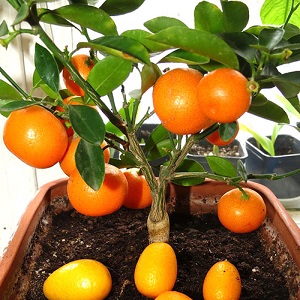 It is quite possible to grow an orange from seeds at home.... Such plants will be more robust and hardy than vegetative trees, but will bear fruit much later. Their crown will be thicker.
It is quite possible to grow an orange from seeds at home.... Such plants will be more robust and hardy than vegetative trees, but will bear fruit much later. Their crown will be thicker.
Orange tree — plant with dark green tough glossy leaves with well-defined veins... The greenery contains glands that secrete essential oils. They flavor the air in the apartment and cleanse it from harmful microorganisms.
Blooming orange looks beautiful: A plant with a dense crown forms a large number of miniature flowers of white or cream color. At the same time, the air is filled with a delicate delicate aroma. Flowering lasts several weeks.
Orange fruits are small, spherical, at maturity - bright orange. The fruits grown on the windowsill are good for eating.
Reference! All citrus fruits grown in a pot are capable of bearing fruit at home. This usually occurs at 8-10 years of life of the tree. However, using some tricks, it is possible to get the first harvest already in 5 years.
An orange tree can bloom and bear fruit without grafting.... However, this procedure significantly brings the timing of the appearance of the first harvest.
Optimal conditions
To get not just a decorative, but a fruiting plant, he is provided with conditions suitable for growth and development:
- Air humidity not lower than 40%, optimal - 80%.
- Temperature in summer and spring, at the beginning of autumn, it is maintained within + 18 ... + 20 ° C. In winter, plants do well at + 14 ° C.
- From mid-spring to mid-autumn, the orange tree has plenty of natural light. In winter, the plant is illuminated with a phytolamp so that its daylight hours were at least 7 hours.
Planting seeds
Orange seeds are planted at any time of the year, but it is better to do it in spring or summer. So the chances that the seeds will sprout and the plants will take root increase.
Attention! From an orange seed bought in a store, not the usual fruits will grow, but small fruits of the "wild".
Selection and preparation of planting material
Orange seeds are purchased from horticultural stores or obtained from fruit. To get the maximum number of shoots, it is important to be able to choose seeds and fruits.

For planting material, fruits with an even, bright peel without green spots are suitable., traces of illness and damage. They must have the correct round shape. It is best to take seeds from several oranges, preferably different varieties.
The seeds, suitable for planting, are large, round and light, without dark spots or damage... Dark, flattened or small seeds will not work.
Interesting on the site:
How to grow a lemon from a seed at home
To speed up germination, increase the germination rate and get healthy, hardy shoots, it is important prepare the bones correctly:
- Extracted from the fetus seeds are cleaned of pulp and washed under running water room temperature.
- Bones disinfected for 30 minutes in Fitosporin, hydrogen peroxide or a dark pink solution of potassium permanganate.
- To awaken the seeds are immersed for 15 minutes in water with a temperature of + 50 ° C. Then they are thrown into ice water for 5 minutes.
- To speed up germination, planting material is soaked overnight in a growth stimulant: "Epine" or aloe juice, diluted in half with water.
If desired, the seeds are germinated in advance... To do this, they are wrapped in a napkin moistened with warm water, placed on a saucer and placed in a warm place. Cover the saucer with plastic wrap. The material is moistened as it dries. They start planting as soon as the seeds hatch.
Advice! To speed up the germination of seeds, some gardeners remove the hard shell from them. In this case, it is important not to damage the cotyledons.
Preparation of containers and soil
The health and speed of seed germination largely depend on the quality of the soil.... They buy it in specialized stores (a universal mixture or citrus soil is suitable) or prepare it yourself.
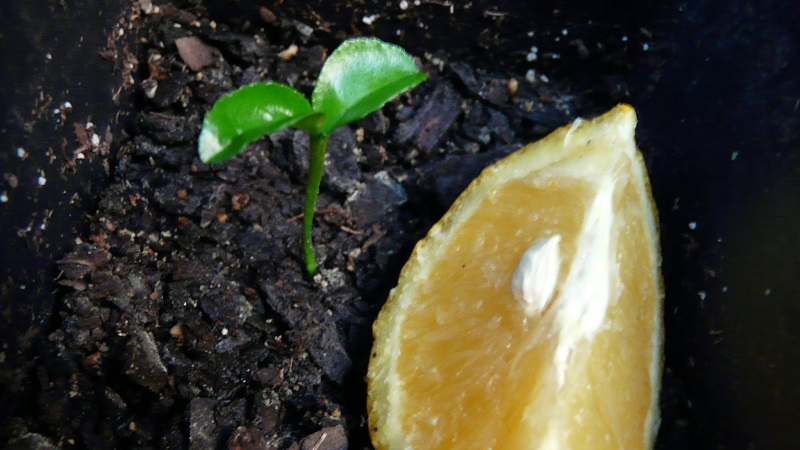
In the latter case, mix:
- garden land - 1 part;
- humus - 1 part;
- peat or sand - 0.5 parts;
- ash - 1 tbsp. for 1 bucket of soil mixture;
- superphosphate - 1 matchbox for 1 bucket of soil mixture.
Purchased and homemade soil is disinfected... To do this, it is calcined in the oven, poured with copper sulfate (1 tbsp. Of substance is taken in a bucket of water), a dark pink solution of potassium permanganate or "Fitosporin".
In addition to soil, drainage is used (shell rock, crushed ceramics, fine gravel, special glass). It is also disinfected.
It is recommended to sow more seeds than you plan to get the plants. Usually the seeds are planted in a common container.:
- wooden box;
- plastic tray;
- pot;
- a cut bottle;
- packaging from under the cake.
Other materials at hand will do.... Drainage holes are made at the bottom. The containers are disinfected by soaking in boiling water or a dark pink solution of potassium permanganate.
Step by step description of landing
Step-by-step landing:
- To the bottom of the container pour a drainage layer 1 cm thick.
- Remaining volume fall asleep with soil.
- The soil is moistened from a spray bottle.
- Bones planted in the ground to a depth of 1.5-2 cm at a distance of 5 cm from each other.
Growing an orange
Growing culture on the windowsill is easy... It is enough to follow the basic rules of care at different stages of plant life.
A beautiful orange tree like this photo will only work with proper care.
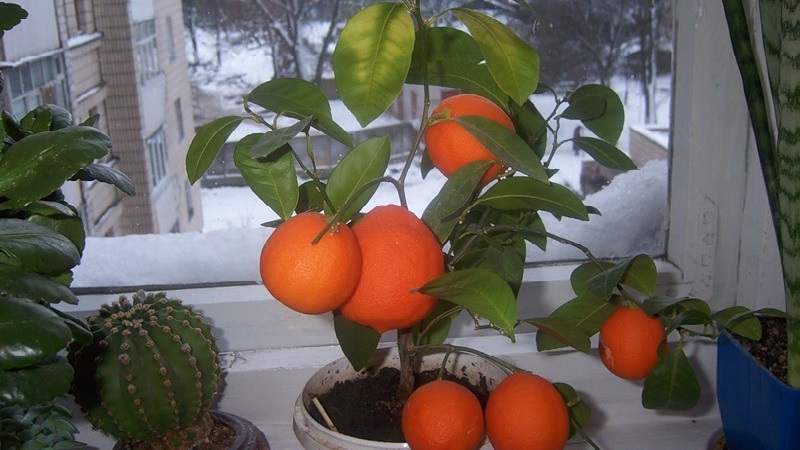
Sprout care
As long as the oranges are growing in a common box, caring for them will be different. from growing older trees:
- Before germination orange seed boxes are kept warm... If the containers are on the windowsill, foam plastic or other insulation is placed under them.
- Before the appearance of 2 true leaves, the sprouts require increased humidity. air and complete isolation from any weeds. This is achieved by creating an impromptu greenhouse. The boxes are covered with foil. If the culture is grown in a bottle, cover it with the trimmed portion. For a cake box, a transparent bottom of the package is suitable.
- Plants ventilateopening the film daily for an hour. A few days before the parsing of the "greenhouse", the airing time is gradually increased, bringing it to a whole day.
- Water the oranges as the topsoil dries out... Use warm water from a spray bottle.
At this stage, the plants are not fed... They are treated with care, protected from drafts and direct sunlight.
Selection of seedlings and picking
Seedlings dive into individual containers after the appearance of 4 leaves... The best plants are selected. They are determined by the following criteria:
- small distance between leaves;
- bright green leaves;
- thick stem;
- elastic leaves and stem.
All weak, stunted and pale plants are removed or thinned out at the stage of 2 leaf formation.
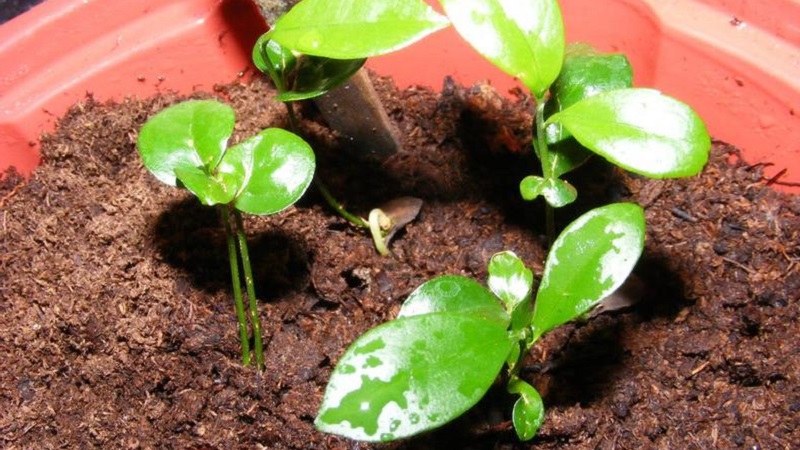
Dive oranges into individual clay pots 8-10 cm in size with drainage holes.
The soil for seedling and picking oranges is different. This time the ingredients are taken in the following proportions:
- sod land - 2 parts;
- humus - 1 part;
- peat - 1 part;
- sand - 1 part.
The soil is disinfected. Before pouring it into the pot, drainage is poured at the bottom. The soil is pre-moistened.
Selected the plants are carefully removed from the box, taking care not to damage the root system... It is convenient to do this with a fork. Water the oranges abundantly before removing them. So they will be removed from the ground much easier.
Plants transplanted into pots without deepening the root collar... The soil around is compacted.
Attention! When compiling a soil mixture for subsequent transplants, the amount of sod is increased to 3 parts, 1 part of clay is added to the composition.
Further care
After transplant care is given special attention... It depends on its correctness whether the tree will take root and whether it will bloom:
- Oranges are watered daily in summer... In winter and late autumn, watering is reduced to 2 times a week. Use only settled water at room temperature.
- Orange tree sprayed every other day.
- In spring, summer and autumn, fertilizers are applied every 2 weeks.... In winter, feeding is stopped.
- In the summer, at noon, the orange is taken away from the window... Every day, the pot is turned a few centimeters around its axis so that the tree develops evenly.
- The first 3 years, the plant is transplanted annually... Then - once every 2-3 years. Each time the diameter of the pot should be 5-10 cm larger than the previous one.
- As homemade oranges are not pollinated by insects, they do it on their own: with a soft brush, touch the middle of one flower and transfer pollen to another. Thus, all inflorescences are processed.
- At the first flowering, remove half of the flowersto keep the orange from dropping everything.
- In the first fruiting, only 3-4 ovaries are left, the most developed and regular form. The next year, 7 fruits are left. Further, the ovaries are not cut off.
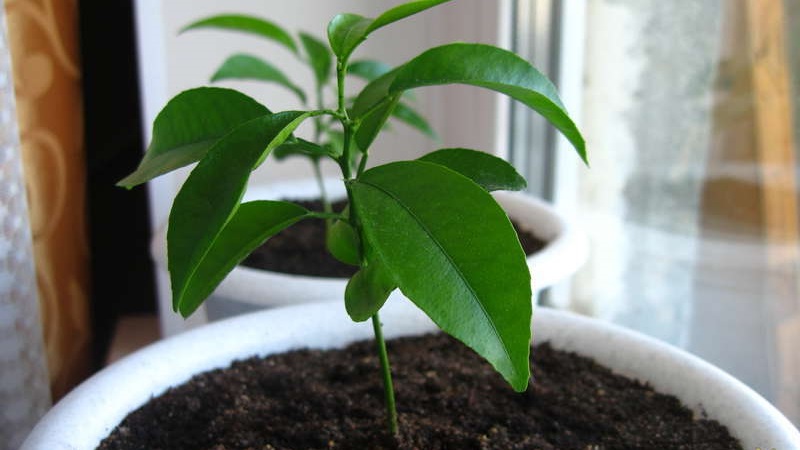
The correct formation of an orange is the key to its flowering and fruiting... Use the following scheme:
- the growth point of the main branch is pinched at a height of 15 cm;
- all subsequent shoots are pinched when they reach 15 cm;
- the upper leaves are left intact, and the 2 leaves underneath are plucked to stimulate the buds to eject shoots.
Fruits appear on branches of the 5th order... This means that the first crop will be harvested no earlier than in 5 years.
Pay special attention to fertilizers... Use a special citrus dressing or prepare it yourself. To do this, dissolve in a 10 liter bucket of water:
- nitrogen fertilizers - 20 g;
- superphosphate - 25 g;
- potassium salts without chlorine - 15 g.
Once a season, copper sulfate is added to the fertilizer, every month - potassium permanganate.
Important! Chlorine is harmful to oranges. Therefore, fertilizers for this plant are chosen without this substance, and only settled water is used for irrigation.
Graft
The tree bears fruit even without grafting, but with its help it will be possible to bring the first harvest closer and make the fruit more delicious.
Inoculate an orange for 1-2 years of life:
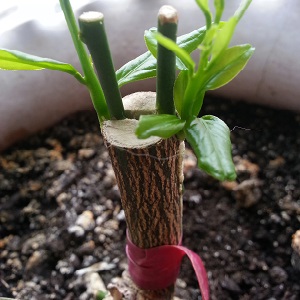 On a seedling obtained from a seed, cut the top leaves... This is not done on the scion.
On a seedling obtained from a seed, cut the top leaves... This is not done on the scion.- On the stem of the plant to which the cutting will be grafted, do cleavage (1 cm deep cut in the center).
- The lower part of the cutting is grinded to a height of 1 cm at an angle on both sides.
- The stalk is inserted into the cleft so that it goes in as tightly and deeply as possible.
- The junction of the scion with the stock is wrapped with grafting tape or electrical tape from the bottom up as tightly as possible (if even the slightest hole remains, the scion will not take root);
- A pot of orange is placed in a Zip Lock bag, at the bottom of which water is poured.
- The bag is closed and put away in a warm, sunny place. Filmed after 2 weeks.
Will help you understand the vaccination process video at the end of the article.
Read also:
Protection against diseases and pests
At home, the orange affects aphids, scale insects and spider mites.... To get rid of pests, they are removed by hand with a rag dipped in soapy water. Plants are sprayed with a decoction of onion peels.
Most often, the orange on the windowsill suffers from root rot.... To combat it, the soil is watered with "Fitosporin". Use a solution of tooth powder (1/2 tbsp. Water, 2 tbsp. L. Tooth powder and ash, 1 tbsp. L. Copper sulfate). The stem is moistened with it near the ground, the plant is not moistened for a week and is removed to a dry place.

Useful tips on the topic
Tips to make it easier to grow oranges and get a rich harvest experienced gardeners:
- If the plant is left at temperatures below + 10 ° C in winter, water 1-2 times a month and do not feed, then in the spring, when leaving resumes, it will grow faster. This will speed up the appearance of the fruit.
- Other citrus fruits are grafted into the orange. plants.
- Yellowing of the leaves indicates a lack or excess of watering, lack of fertilizer or exposure to drafts on the plant.
- To reduce the risk of orange contamination and improve its photosynthesis, once a week the leaves are wiped from dust with a damp cloth.
- Plants affected by insects are washed in the shower room temperature.
Conclusion
Growing an orange from a seed is real. With proper care, it will delight you not only with beautiful flowering, but also with a delicious harvest.
Fruits in the wild appear in 7-8 years, are small, sour and tart. Proper care and knowledge of some tricks will help bring fruiting closer and improve the quality of citrus fruits.